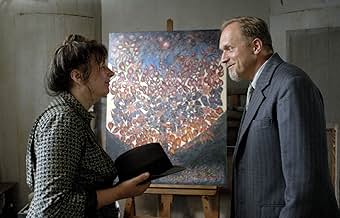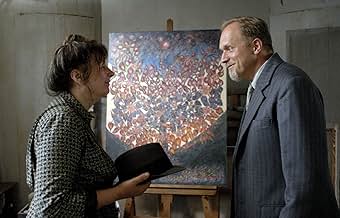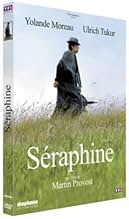IMDb रेटिंग
7.4/10
6.7 हज़ार
आपकी रेटिंग
फ्रांसीसी चित्रकार सेरेपीन डी सेनलिस के जीवन पर आधारित.फ्रांसीसी चित्रकार सेरेपीन डी सेनलिस के जीवन पर आधारित.फ्रांसीसी चित्रकार सेरेपीन डी सेनलिस के जीवन पर आधारित.
- पुरस्कार
- 20 जीत और कुल 10 नामांकन
Léna Breban
- Soeur Marguerite
- (as Léna Bréban)
Sandrine Bodenes
- Marie-Louise
- (as Sandrine Bodènés)
Anne Benoît
- Madame Delonge
- (as Anne Benoit)
फ़ीचर्ड समीक्षाएं
Veteran actress Yolande Moreau gives a dedicated performance in this biopic about the neo-primitive, or "naive," or "outsider" flower painter Séraphine Louis (1864-1948), now called Séraphine de Senlis, from the town where she worked. An orphan looked down on by all, she survived barely by doing cleaning and laundry paid by the job, but in her little room in town at night by candlelight made strange, visionary paintings of flowers in large clusters, looking like diamonds or insects. Raised and cared for in early life by nuns, she sang to the Virgin when she finished a painting. Beautifully photographed, meditative, with a strong sense of the quietude of rural France in the teens and twenties, this picture doesn't provide deep insight into either Séraphine or the German art collector who discovered and supported her, Wilhelm Uhde (Ulrich Tukur, another veteran; he has one of the secondary leads in The Lives of Others). Uhde deserves his own biopic. He was the first to purchase the works of Picasso and discovered the great modern primitive Henri "Le Douanier" Rousseau.
Slowly, methodically, the film shows how Uhde finds out by chance that the haggard looking middle aged woman cleaning up in the big rented house he's living in in Senlis with his sister is doing unique paintings on wood. Nobody else around appreciates them or, in fact, understands modern art. He buys all her work from Séraphine and urges her to concentrate on her art. But WWI comes, and as a German he is forced to leave precipitously, leaving behind his little notebook and most of the art he's collected in France.
Uhde returns years later with his sister and also a male lover, Helmut Kolle (Nico Rogner), a talented young German expressionist painter dying of TB, and rents another house in the area. He comes across Séraphine's work and finds it more ambitious and much more brilliant. He puts her on a generous monthly stipend. She shows signs of mania, and her disappointment when she finds the Paris exhibition must be put off due to the worldwide financial crisis leads her into insanity. The trajectory is ever downward, though the final scenes suggest that her last years in a sanatorium may have been spend it serenity, close to the nature she loved.
This film is thorough and handsomely made, but a little too much on the dutiful and academic side. It has parallels as a story with Bruno Nuytten's 1988 Camille Claudel, but it has neither the level of drama nor the presence of Gérard Depardieu and Isabelle Adjani (as Rodin and Claudel) to give it energy. As director Provost has said, Uhde had a "dark side": his willingness to virtually abandon Séraphine when things got rough for her, and not to bother looking for her when he first returns to France after the War. Provost leaves this mysterious, which is just historically, but unsatisfying cinematically. But Provost did apparently help organize the recent Musée Maillol exhibition of Séraphine's work. And this film is a thought-provoking addition to the on-screen literature of outsider or visionary art.
The film opened in theaters in Paris on October 1, 2008 to respectful if not overly enthusiastic reviews. It has been bought by Music Box in the US, but no release has been announced. Shown as part of the Rendez-Vous with French Cinema at Lincoln Center, NYC, in March 2009.
Slowly, methodically, the film shows how Uhde finds out by chance that the haggard looking middle aged woman cleaning up in the big rented house he's living in in Senlis with his sister is doing unique paintings on wood. Nobody else around appreciates them or, in fact, understands modern art. He buys all her work from Séraphine and urges her to concentrate on her art. But WWI comes, and as a German he is forced to leave precipitously, leaving behind his little notebook and most of the art he's collected in France.
Uhde returns years later with his sister and also a male lover, Helmut Kolle (Nico Rogner), a talented young German expressionist painter dying of TB, and rents another house in the area. He comes across Séraphine's work and finds it more ambitious and much more brilliant. He puts her on a generous monthly stipend. She shows signs of mania, and her disappointment when she finds the Paris exhibition must be put off due to the worldwide financial crisis leads her into insanity. The trajectory is ever downward, though the final scenes suggest that her last years in a sanatorium may have been spend it serenity, close to the nature she loved.
This film is thorough and handsomely made, but a little too much on the dutiful and academic side. It has parallels as a story with Bruno Nuytten's 1988 Camille Claudel, but it has neither the level of drama nor the presence of Gérard Depardieu and Isabelle Adjani (as Rodin and Claudel) to give it energy. As director Provost has said, Uhde had a "dark side": his willingness to virtually abandon Séraphine when things got rough for her, and not to bother looking for her when he first returns to France after the War. Provost leaves this mysterious, which is just historically, but unsatisfying cinematically. But Provost did apparently help organize the recent Musée Maillol exhibition of Séraphine's work. And this film is a thought-provoking addition to the on-screen literature of outsider or visionary art.
The film opened in theaters in Paris on October 1, 2008 to respectful if not overly enthusiastic reviews. It has been bought by Music Box in the US, but no release has been announced. Shown as part of the Rendez-Vous with French Cinema at Lincoln Center, NYC, in March 2009.
Séraphine was one of these so called common people who in the early 1900s were discovered. The expression "discovered" is not wrong, but that wasn't just about the person, it's was also about another type of seeing and another type of expression.
Séraphine lived a poor and humiliating life like most women of her class. Then this German art collector finds her. But it stops there, because for certain reasons he in the end can't improve her life materially. And the result is disastrous, because it means betrayal of a person, although not of her art.
A silent realistic movie, there you can smell the poverty and despair.
Séraphine lived a poor and humiliating life like most women of her class. Then this German art collector finds her. But it stops there, because for certain reasons he in the end can't improve her life materially. And the result is disastrous, because it means betrayal of a person, although not of her art.
A silent realistic movie, there you can smell the poverty and despair.
Séraphine de Senlis - born Séraphine Louis (1864- 1942) - may not be a painter well known to the entire art world today, but the story of her life makes a compelling film. Writer Marc Abdelnour and writer/director Martin Provost have extracted all of the significant aspects of Séraphine Louis' life and have created a work of art as a film, much in the style of the way she created her life in art.
Séraphine Louis (Yolande Moreau) was born in 1864 in Arcy to a poor family and worked as a shepherdess until 1881 when she accepted the position as a domestic worker for the Sisters of Providence in Clermont: her life with the nuns enhanced her profoundly religious approach to her personal philosophy. In 1901 she left the convent, in part due to a communication with her angel that she must paint, to become a housekeeper for middle class families in Senlis. In her quiet manner she scrubbed floors and did laundry by day, using the pittances of income to procure some supplies so that she could paint her images of fruits, flowers, and leaves by candlelight at night in her tiny room. Self taught, she used pigment from strange sources - blood from the butcher, melted wax from the votives at the cathedral, pollen from the flowers of the fields, her only 'purchased' component was gesso and white paint from the artist supply shop in Senlis.
In 1914 the German art collector and critic Wilhelm Uhde (Ulrich Tukur) took a room in the house owned by Mme Duphot (Geneviève Mnich), one of the houses where Séraphine worked, and when Wilhelm discovered a painting by Séraphine he immediately recognized a painter of great promise and provided Séraphine with the first response to her artistic efforts. Wilhelm and Séraphine became friends and Wilhelm bought all of her art, insisting that she devote her time to creating art instead of scrubbing floors. With the backing of a collector and friend, Séraphine began painting in earnest, showing locally and selling art under Wilhelm's sponsorship, until 1914 when with WW I breaking out, Wilhelm had to flee France, leaving behind his collection of paintings as well as the close bond the two had formed. Mistakenly Séraphine thought Wilhelm's departure was to marry his roommate Anne-Marie (Anne Bennett), only to discover that Anne-Marie was Wilhelm's sister and fellow supporter of Séraphine: Wilhelm informed her he would never be able to marry a woman.
Séraphine continued painting as she lead her eccentric life in Senlis and in 1927 Wilhelm returned to France with his paramour - young painter Helmut Kolle (Nico Rogner) who suffered from tuberculosis - rediscovers Séraphine's art in a local Senlis exhibition, and realizes that she had survived and her art had flourished. Under Wilhelm's patronage, Séraphine began painting large canvases as large as two meters high, and she achieved prominence as the naïve painter of her day. In 1929, Wilhelm organized an exhibition, 'Painters of the Sacred Heart', that featured Séraphine's art, launching her into a period of financial success she had never known - and was ill prepared to manage. Then, in 1930, with the effects of the Great Depression destroying the finances of her patrons, Wilhelm had no choice except to stop buying her paintings. Séraphine's spending habits cause concern and in 1932 her psychotic behavior resulted in placement in the psychiatric ward in Clermont hospital where she spent the rest of her days, alone and without friends or admirers of her gift of art.
The simplicity of the manner in which this story is related with very little dialogue, atmospheric scenery as captured by cinematographer Laurent Brunet, and a musical score by Michael Galasso that combines sacred chants with idiomatic instrumental music of French ancestry. Yolande Moreau glows with a special radiance as the simple, spiritual, artistically driven Séraphine and Ulrich Tukar is the perfect balance as his own driven, unique 'first true collector'. This film is a little masterpiece and one that deserves the attention of everyone who cares about the lives of artists and the emergence of genius from strange vessels.
Grady Harp
Séraphine Louis (Yolande Moreau) was born in 1864 in Arcy to a poor family and worked as a shepherdess until 1881 when she accepted the position as a domestic worker for the Sisters of Providence in Clermont: her life with the nuns enhanced her profoundly religious approach to her personal philosophy. In 1901 she left the convent, in part due to a communication with her angel that she must paint, to become a housekeeper for middle class families in Senlis. In her quiet manner she scrubbed floors and did laundry by day, using the pittances of income to procure some supplies so that she could paint her images of fruits, flowers, and leaves by candlelight at night in her tiny room. Self taught, she used pigment from strange sources - blood from the butcher, melted wax from the votives at the cathedral, pollen from the flowers of the fields, her only 'purchased' component was gesso and white paint from the artist supply shop in Senlis.
In 1914 the German art collector and critic Wilhelm Uhde (Ulrich Tukur) took a room in the house owned by Mme Duphot (Geneviève Mnich), one of the houses where Séraphine worked, and when Wilhelm discovered a painting by Séraphine he immediately recognized a painter of great promise and provided Séraphine with the first response to her artistic efforts. Wilhelm and Séraphine became friends and Wilhelm bought all of her art, insisting that she devote her time to creating art instead of scrubbing floors. With the backing of a collector and friend, Séraphine began painting in earnest, showing locally and selling art under Wilhelm's sponsorship, until 1914 when with WW I breaking out, Wilhelm had to flee France, leaving behind his collection of paintings as well as the close bond the two had formed. Mistakenly Séraphine thought Wilhelm's departure was to marry his roommate Anne-Marie (Anne Bennett), only to discover that Anne-Marie was Wilhelm's sister and fellow supporter of Séraphine: Wilhelm informed her he would never be able to marry a woman.
Séraphine continued painting as she lead her eccentric life in Senlis and in 1927 Wilhelm returned to France with his paramour - young painter Helmut Kolle (Nico Rogner) who suffered from tuberculosis - rediscovers Séraphine's art in a local Senlis exhibition, and realizes that she had survived and her art had flourished. Under Wilhelm's patronage, Séraphine began painting large canvases as large as two meters high, and she achieved prominence as the naïve painter of her day. In 1929, Wilhelm organized an exhibition, 'Painters of the Sacred Heart', that featured Séraphine's art, launching her into a period of financial success she had never known - and was ill prepared to manage. Then, in 1930, with the effects of the Great Depression destroying the finances of her patrons, Wilhelm had no choice except to stop buying her paintings. Séraphine's spending habits cause concern and in 1932 her psychotic behavior resulted in placement in the psychiatric ward in Clermont hospital where she spent the rest of her days, alone and without friends or admirers of her gift of art.
The simplicity of the manner in which this story is related with very little dialogue, atmospheric scenery as captured by cinematographer Laurent Brunet, and a musical score by Michael Galasso that combines sacred chants with idiomatic instrumental music of French ancestry. Yolande Moreau glows with a special radiance as the simple, spiritual, artistically driven Séraphine and Ulrich Tukar is the perfect balance as his own driven, unique 'first true collector'. This film is a little masterpiece and one that deserves the attention of everyone who cares about the lives of artists and the emergence of genius from strange vessels.
Grady Harp
Seraphine Louis,who would eventually change her name to Seraphine deSenlis (after the name of her hometown)was an artist who cleaned houses by day,and painted by night (all the time while singing the hymns of her staunch Catholic upbringing,while she was growing up an orphan by Nuns). Seraphine is pretty much maligned by the village locals,taunted by children,and pretty much avoided by most all that know her. When German art collector & critic,Wilhelm Uhde rents a room in the town of Senlis,while on the run from the insanity of World War I,and discovers a painting by Seraphine & is amazed by it's use of colour & texture. When the war moves ever closer,Uhde & his sister escapes the madness. Years later,he returns to Senlis,rediscovers an aged,but still painting Seraphine & vows to put her work on display (despite the fallout of the Wall Street crash of 1929,as well as the subsequent great depression,that managed to cripple a good percentage of Europe's economy,as well). Martin Provost directs & co writes (with Marc Abdelnoir)a lovingly depicted portrait of a woman possessed of genius that is cruelly stolen too early (deSenlis spent her aged years in an insane asylum & never painted again in life). Yolande Moreau plays Seraphine,a woman unpossesed by pretentious,real fine. Ulrich Tukur plays Wilhelm Uhde,in a winning role that depicts Uhde as an impresario of art first,and who's personal life is down played,somewhat (in life,Uhde was an ardent homosexual that made no bones about his gay lifestyle). The photography is a real treat for the eye (at times,the composition of visual images are very painterly,such as films such as 'Tous Le Matin Du Monde'). A film to check out for those with a love of art,or art history (or both). Spoken in French & German with English subtitles. Not rated by the MPAA,this film contains flashes of nudity & adult content.
A frumpy cleaning woman well into middle age is discovered by an art critic to be a painter with talent comparable to Vincent Van Gogh. Her story is told in the riveting Seraphine, directed by Martin Provost and winner of seven Césars, the French version of the Oscars, including a best actress award for Yolande Moreau. With a screenplay by Martin Provost and Marc Abdelnour, the film is set in the village of Senlis outside of Paris where Séraphine Louis (Yolande Moreau) lives alone and must take odd jobs just to pay for her painting supplies. Séraphine is a visionary, a devout Catholic who believes she is guided by a guardian angel and her exotic paintings of flowers and plants describe her feelings of closeness to spirit.
Treated with disdain by her condescending employer, her life takes on new meaning when a tenant, German art critic Wilhelm Uhde (Ulrich Tukur) hires Séraphine to clean for him and accidentally discovers one of her paintings that her boss had tossed aside. A champion of modern "primitvist" artists who is credited with early recognition of Picasso and Rousseau, Uhde is portrayed by Tukur as a quiet, unassuming man who lives with his sister and a gay lover. He recognizes Séraphine's talent but never shows much enthusiasm, preferring to keep their relationship on a very business-like basis.
Impressed by Seraphine's passionate art, Uhde offers to become her patron but, feeling estranged in France, must soon leave the country to return to Germany as the First World War begins. Although Séraphine continues to paint, she has no connection with Uhde until the latter part of the 1920s when he provides her with the means to quit her job and paint full time. Unfortunately, her grip on reality falters and she is soon hospitalized after indulging in spending sprees on a wedding dress and purchase of a large mansion. One of the saddest scenes in the film is that of Séraphine dressed in a full wedding gown, going door to door giving her away her possessions.
Provost in Séraphine captures the artist's mystical nature and her close bond with nature that shows up in her works, which are still exhibited in many of the world's museums. She is shown hugging trees, climbing them, and standing as a tiny speck beneath a towering shade tree. One scene shows her standing nude in water up to her chest in a nearby river. Provost takes a minimalist approach and the film does not contain much dialogue. The story is told by the silences and facial expressions and the music by Michael Galasso adds richness to the experience. Fully capturing the eternal mystery of the creative process, Séraphine itself is a work of art.
Treated with disdain by her condescending employer, her life takes on new meaning when a tenant, German art critic Wilhelm Uhde (Ulrich Tukur) hires Séraphine to clean for him and accidentally discovers one of her paintings that her boss had tossed aside. A champion of modern "primitvist" artists who is credited with early recognition of Picasso and Rousseau, Uhde is portrayed by Tukur as a quiet, unassuming man who lives with his sister and a gay lover. He recognizes Séraphine's talent but never shows much enthusiasm, preferring to keep their relationship on a very business-like basis.
Impressed by Seraphine's passionate art, Uhde offers to become her patron but, feeling estranged in France, must soon leave the country to return to Germany as the First World War begins. Although Séraphine continues to paint, she has no connection with Uhde until the latter part of the 1920s when he provides her with the means to quit her job and paint full time. Unfortunately, her grip on reality falters and she is soon hospitalized after indulging in spending sprees on a wedding dress and purchase of a large mansion. One of the saddest scenes in the film is that of Séraphine dressed in a full wedding gown, going door to door giving her away her possessions.
Provost in Séraphine captures the artist's mystical nature and her close bond with nature that shows up in her works, which are still exhibited in many of the world's museums. She is shown hugging trees, climbing them, and standing as a tiny speck beneath a towering shade tree. One scene shows her standing nude in water up to her chest in a nearby river. Provost takes a minimalist approach and the film does not contain much dialogue. The story is told by the silences and facial expressions and the music by Michael Galasso adds richness to the experience. Fully capturing the eternal mystery of the creative process, Séraphine itself is a work of art.
क्या आपको पता है
- ट्रिवियाSince the film's release, the number of visitors at the museum of Senlis exhibiting Séraphine's works has quadrupled (August 2009).
- गूफ़The film opens in 1914 showing the arrival of Wilhelm and Anne-Marie at the village. Wilhelm actually arrived in 1912, two years before the start of the war.
- क्रेज़ी क्रेडिटThe credits list the names of the paintings which are seen in the film - 10 paintings by Séraphine and the artworks owned by Uhde and Kolle.
- साउंडट्रैकConsonent laudes!
Written by Louis Rousseau
Performed by Yolande Moreau, Françoise Lebrun and Léna Breban
टॉप पसंद
रेटिंग देने के लिए साइन-इन करें और वैयक्तिकृत सुझावों के लिए वॉचलिस्ट करें
- How long is Seraphine?Alexa द्वारा संचालित
विवरण
- रिलीज़ की तारीख़
- कंट्री ऑफ़ ओरिजिन
- आधिकारिक साइटें
- भाषाएं
- इस रूप में भी जाना जाता है
- Seraphine
- फ़िल्माने की जगहें
- उत्पादन कंपनियां
- IMDbPro पर और कंपनी क्रेडिट देखें
बॉक्स ऑफ़िस
- बजट
- €36,74,000(अनुमानित)
- US और कनाडा में सकल
- $8,84,613
- US और कनाडा में पहले सप्ताह में कुल कमाई
- $38,637
- 7 जून 2009
- दुनिया भर में सकल
- $94,02,702
- चलने की अवधि2 घंटे 5 मिनट
- रंग
- ध्वनि मिश्रण
- पक्ष अनुपात
- 1.85 : 1
इस पेज में योगदान दें
किसी बदलाव का सुझाव दें या अनुपलब्ध कॉन्टेंट जोड़ें



































